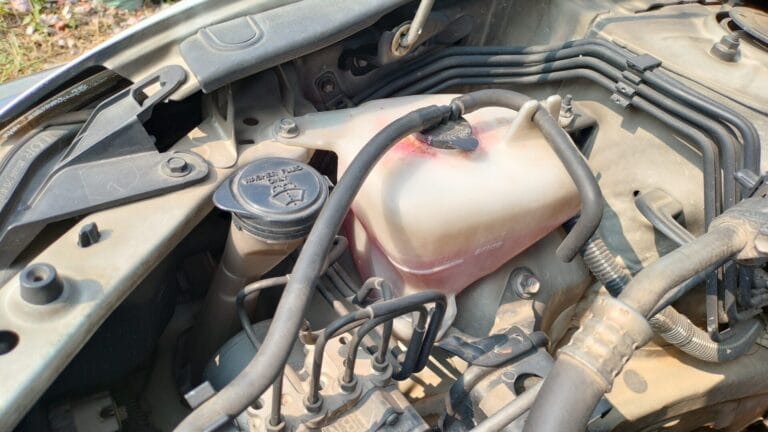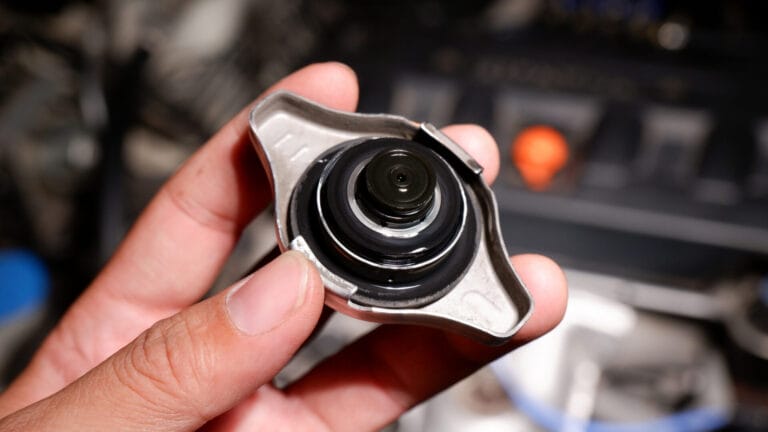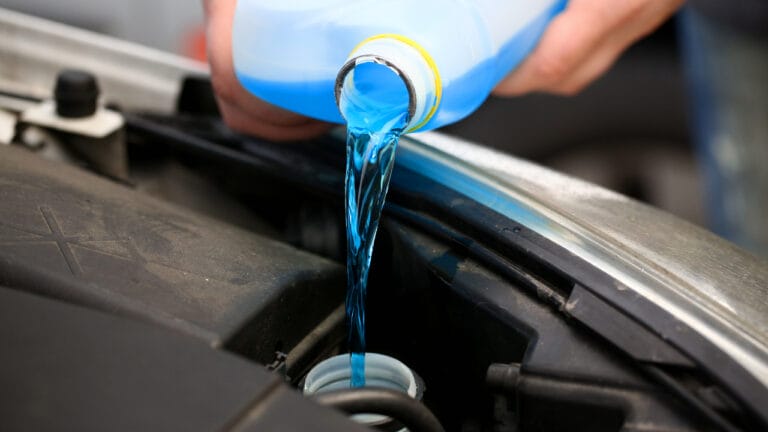Car Coolant System
What stops your car’s engine from going up in flames like a Fourth of July bonfire? It’s your trusty coolant system filled with magic fluid (coolant/antifreeze). Coolant flows through your engine like a cool breeze on a hot summer day, whisking away excess heat and keeping things running like a well-oiled machine.
Without coolant, your engine would toast faster than you would say, “Hot rod.” Coolant is like the silent guardian of your car, working tirelessly to keep things cool under pressure.
So, if you’re ready to peel back the hood and uncover the mysteries of the coolant system, buckle up and join me for a journey through the heart of your car’s cooling mechanism.
Let’s hit the road and see what lies ahead!
Coolant System and How It Works
So, before we get into the nuts and bolts of how it all works, let’s first spotlight the key players on this cooling team. After all, understanding the components is the first step towards mastering how they work together to keep your engine running efficiently.
- Radiator,
- Water pump,
- Thermostat
- Hoses and pipes
- Coolant reservoir
Let’s take a closer look at how a coolant system works and how each component contributes to it.
- Heat Dissipating

Radiator is hanging out at the front of your car; you can say the command center, ready to take on the heat. Its job? To dissipate heat from the hot coolant flowing through it, acting like a giant heat exchanger. As the coolant passes through the radiator, it’s cooled down by air flowing over its fins, which helps regulate the engine temperature. Without the radiator, heat buildup in the engine would quickly lead to overheating and potential damage. The radiator is the cool customer that keeps your engine from boiling over, ensuring smooth sailing on the road ahead.
- Coolant Circulation

Meet the water pump, which constantly spins and circulates coolant from the engine block and back again, ensuring that heat generated by the engine is transferred away efficiently. Without the water pump, coolant wouldn’t circulate, leading to overheating and potential engine damage. Essentially, the water pump is the driving force behind keeping your engine cool and running smoothly.
- Regulating the Flow

Ah, the thermostat—a tiny but mighty little gadget. It’s like the brains of the operation, constantly monitoring the temperature and regulating the flow of coolant to keep things just right. When the engine is cold, it remains closed, allowing coolant to circulate internally for quicker warm-up. Once the engine reaches the ideal temperature, the thermostat opens, directing coolant to the radiator for cooling. Without this small but essential component, your engine would struggle to maintain its temperature, leading to potential overheating and performance issues.
- Transporting Coolant with Precision

Don’t underestimate the humble hoses and pipes—they may not be flashy, but they’re essential for keeping the coolant flowing smoothly throughout the system. They’re like the veins and arteries of your car, transporting coolant to all the nooks and crannies where it’s needed most.
These are the lifelines of your engine, connecting all the essential components—from the radiator to the water pump to the engine itself. Without them, coolant wouldn’t circulate properly, leading to overheating and potential engine damage.
- Ensuring a Ready Supply

Last but not least, we have the coolant reservoir, aka the backup plan. It serves as a storage tank for extra coolant, ensuring enough to top off the system when needed. Without the coolant reservoir, you’d have to constantly monitor and replenish coolant levels manually, which could be a real hassle.
Importance of Coolant in Cooling Systems
Coolant is more than just a colorful liquid coursing through your car’s veins; it’s the magic fluid that keeps your engine running smoothly. Its importance cannot be overstated, as it plays multiple crucial roles in maintaining optimal engine temperature and performance.
Heat Transfer
Coolant’s main job is to absorb excess heat and transfer it. As the engine burns fuel to produce power, it generates an immense amount of heat. That’s when coolant swoops in like a cool breeze to absorb this heat and prevent your engine from reaching meltdown mode.
Corrosion Inhibitor
Coolant is not a one-trick pony; it contains additives that form protective barriers on metal surfaces. The harsh operating conditions within the engine can cause metal surfaces to corrode over time, leading to leaks, component failure, and costly repairs. Coolant prevents this corrosion and extends the lifespan of engine components.
Lubrication for Water Pump
Coolant also lubricates the water pump. Without proper lubrication, the pump can wear out prematurely, leading to coolant circulation issues and overheating.
Prevent Freezing and control boiling Point.
In cold weather conditions, coolant prevents the water in the engine from freezing, avoiding potential damage to engine components. Conversely, in hot weather conditions, coolant raises the boiling point of the water, preventing vaporization and maintaining proper engine temperature regulation.
Consistent Engine Temperature
Coolant helps to maintain consistent engine temperature, ensuring optimal fuel combustion and engine efficiency. Any fluctuations in engine temperature can lead to poor fuel economy, reduced power output, and increased emissions. Coolant ensures the engine operates within the optimal temperature range, maximizing performance and fuel efficiency.
How To Monitor Car Coolant Levels
You should regularly monitor your car’s coolant level to maintain optimal engine performance and prevent overheating. Generally, it’s best to check your coolant level at least once a month or every 3,000 miles. However, it’s advisable to check it more frequently in extreme temperatures.
Plus, before going on a long trip, you should check the coolant level, and on the way, you should monitor your engine for signs of overheating or coolant leaks. Let’s know how to check your car coolant level and some signs to understand low coolant without checking.
Checking Coolant Level

- The coolant reservoir is a translucent plastic tank located near the radiator or firewall. Its side has “coolant” or “antifreeze” markings.
- Open the reservoir and look closely at the markings on the side of the coolant reservoir to determine the current coolant level. Ideally, the coolant level should fall between the “min” and “max” markings when the engine is cold.
- If the level is under the “max” but not too close to the “min,” it’s good. But if it’s below the “min” marking, the coolant is low and needs immediate top-up.
- One more thing: note the coolant’s color while checking the coolant level. Fresh coolant is typically bright and clear, with a vibrant hue. But if it appears dirty or cloudy, the coolant is contaminated with dirt, rust, or other debris. Flush and refill immediately.
Low Coolant Levels/Coolant Leak
Driving with a coolant leak is risky and should be avoided. A leak means coolant levels drop, reducing the engine’s ability to cool effectively potentially leading to overheating, engine damage, or breakdowns. Here are signs that indicate low coolant or a coolant leak.
Signs of Low Coolant Level/Coolant Leaks
- Unusual Liquid Under the Vehicle
If you notice a pool of liquid or stains under your car, it’s a red flag for a coolant leak. Coolant typically has a distinct color—green, orange, or pink—and if you see this under your car, it’s time to check your coolant levels.
- Engine Overheating Issues
An overheating engine is one of the most serious signs of low coolant levels. If your engine temperature gauge starts creeping into the red zone or if you see steam coming from under the hood, there’s a good chance that low coolant levels are to blame.
- Distinctive Sweet Smell
Coolant has a sweet, syrupy aroma, so if you catch a whiff of this distinctive smell near your car, it could indicate a coolant leak. Don’t let the pleasant scent fool you—it’s a sign that coolant is escaping and needs immediate attention.
- Dashboard Warning Lights
Many modern vehicles have dashboard warning lights that indicate low coolant levels or engine overheating. If you see these lights illuminate, you must check your coolant level and look for signs of a leak.
- Unusual Engine Sounds or Performance Issues
Listen for unusual sounds like gurgling, bubbling, or hissing from the engine bay. These noises can indicate air pockets in the cooling system due to low coolant levels. Performance issues such as a sudden loss of power or rough idling can signal a coolant problem.
- Frequent Need to Top Up Coolant
If you have to add coolant frequently without an apparent reason, it’s a sign of a leak. Coolant levels should remain consistent, so if you’re topping up more than usual, there’s likely a problem with the cooling system.
- Visible Leaks Around the Water Pump or Radiator
Check around the water pump and radiator for visible signs of leaks. Any dampness, residue, or drips in these areas could indicate a coolant leak. Even a tiny leak can lead to significant problems if not addressed promptly.
How Long Should I Wait To Put Coolant in My Car
If you notice any of the above signs, the best action is to pull over safely, turn off the engine, and let it cool down for at least 30 minutes before checking coolant levels.
Because when the engine is running, coolant circulates through it, absorbing heat and carrying it to the radiator, where it is cooled before returning to the engine. If there’s a low coolant level or a leak in the radiator, this heat transfer process is disrupted, leading to engine overheating.
If you’re not in a rush, it’s always best to give your engine a break and cool off naturally before inspecting or refilling the coolant. This way, you avoid the risk of burns or other injuries from a hot radiator or steam release.
Consequence Of Driving with low coolant or a Coolant Leak,
Even if you have enough coolant to reach your destination, driving with a coolant leak is a gamble that can endanger your engine’s well-being and your safety. It increases the risk of severe engine issues, such as a blown head gasket, warped cylinder head, or damaged radiator. Additionally, a severe coolant leak can result in the coolant mixing with engine oil, compromising lubrication and leading to catastrophic engine failure.
It also poses safety hazards besides engine damage. Coolant spilling onto hot engine parts can produce steam, smoke, and fire risks, while toxic coolant exposure can be harmful if inhaled or ingested.
So, don’t risk your engine’s health! If you suspect low coolant or a coolant leak, pull over and address it immediately. The cost of neglect could be much higher than a simple repair.
Consequence Of Driving with Water in the Radiator
Driving with water in the radiator instead of a proper coolant can lead to significant engine risks. Coolant does more than just keep your engine from overheating—it contains additives to prevent corrosion, raise the boiling point, and lubricate key components like the water pump. Water lacks these properties, making it a poor substitute in the long term.
If you rely on water instead of coolant, you risk engine overheating, especially during high temperatures or long drives. Water evaporates faster, reducing cooling efficiency and potentially causing engine damage, such as warped cylinder heads, blown head gaskets, and cracked engine blocks.
Given these risks, driving with water in the radiator is not recommended. If you must use water as a temporary solution, do so only for short distances and at lower speeds, and prioritize seeking professional help as soon as possible.
Consequence Of Driving without a Coolant Reservoir Cap
Driving without a coolant reservoir cap can lead to a cascade of engine problems. Without it, the system can’t maintain proper pressure, leading to overheating and potential engine damage.
Coolant loss is another significant risk, as the cap prevents coolant from evaporating or leaking out. Without the cap, coolant escapes more efficiently, putting additional strain on the engine. This can damage seals, gaskets, and other critical components, resulting in costly repairs.
So, if your cap is missing or damaged, replace it ASAP. Need more info on cooling system care? Check out our detailed guide on Can You Drive Without a Coolant Reservoir Cap.
Can You Use Water Instead of Coolant in Car Coolant System?
No, you can’t use water instead of a coolant in your car’s coolant system.
As coolant is a mixture of water and antifreeze, many of us think that only water may help in an emergency. But that’s not the case. You can’t drive a long way with water in the radiator. Water lacks the specialized properties of coolant, making it less effective at regulating engine temperature. It also increases the chance of engine overheating, especially during high-temperature conditions. Furthermore, using only water in the radiator raises the risk of coolant freezing in colder climates.
Although water may be a solution in an emergency, it should not be used as a long-term substitute. Read our in-depth guide on coolant’s importance in cooling systems to learn why using the proper coolant mix is essential for preventing engine damage and maintaining peak performance.”
Coolant System Maintenance
The coolant reservoir is where excess coolant is stored, so keeping it clean and functional is vital. Periodically clean the reservoir to remove sediment or debris, and inspect the reservoir cap for wear or damage. A faulty cap can lead to coolant leaks and pressure loss, affecting the entire cooling system.
Let’s know five maintenance tips.
- Regular Inspections:
Regular inspections are essential to ensure your coolant system is in top condition. Check the coolant reservoir for any visible signs of leaks, such as puddles or stains under the car, and examine the coolant itself for color and clarity. Fresh coolant should be bright and clear; if it’s cloudy or discolored, it might be contaminated and need flushing. Additionally, inspect hoses, clamps, and connections for wear, cracking, or bulging signs.
- Flush and Replace:
Your coolant system needs regular flushing to remove old coolant and any accumulated debris or rust. Follow the manufacturer’s recommendations for coolant flush and replacement intervals, typically every 2-5 years. Flushing involves draining the old coolant, flushing the system with a cleaning solution or water to remove contaminants, and refilling with fresh coolant. This process helps maintain optimal cooling system efficiency and prevents long-term issues.
- Pressure Test:
Pressure testing the cooling system is critical in identifying potential leaks or weak points. A pressure tester is used to pressurize the system, simulating the conditions under which it operates. If the system cannot hold pressure, a leak must be addressed. Pressure testing can reveal hidden issues such as radiator cracks, faulty gaskets, or worn hoses.
- Inspect Water Pump:
The water pump is the heart of your coolant system, circulating coolant throughout the engine. During regular inspections, check for any signs of leaks around the water pump. A damaged or corroded water pump can lead to coolant leaks and reduced circulation. Also, inspect the pump’s drive belt for signs of wear or looseness, which can affect its ability to function properly.
- Maintain Thermostat and Reservoir:
The thermostat regulates coolant flow, ensuring the engine operates at the correct temperature. Test the thermostat’s functionality by observing how quickly the engine warms up and checking for consistent temperature levels during driving. If it seems sluggish or inconsistent, it may need replacing.
Closing Words
In conclusion, the coolant system maintains optimal engine temperature and performance. Coolant ensures smooth operation mile after mile, from dissipating heat to protecting engine components.
So, whether it’s low coolant levels, leaks, or thermostat malfunctions, you can save time, money, and headaches by staying proactive and performing routine inspections and flushes.
For more tips on keeping your car in top condition, explore AutoFixGenius comprehensive car care guides. From brake fluid circulation to AC maintenance, we’ve covered you with expert advice and insights to help you confidently navigate the road ahead.
Thank you for joining us on this journey to understanding the coolant system. Remember, a well-maintained coolant system is the key to a happy and healthy car!






